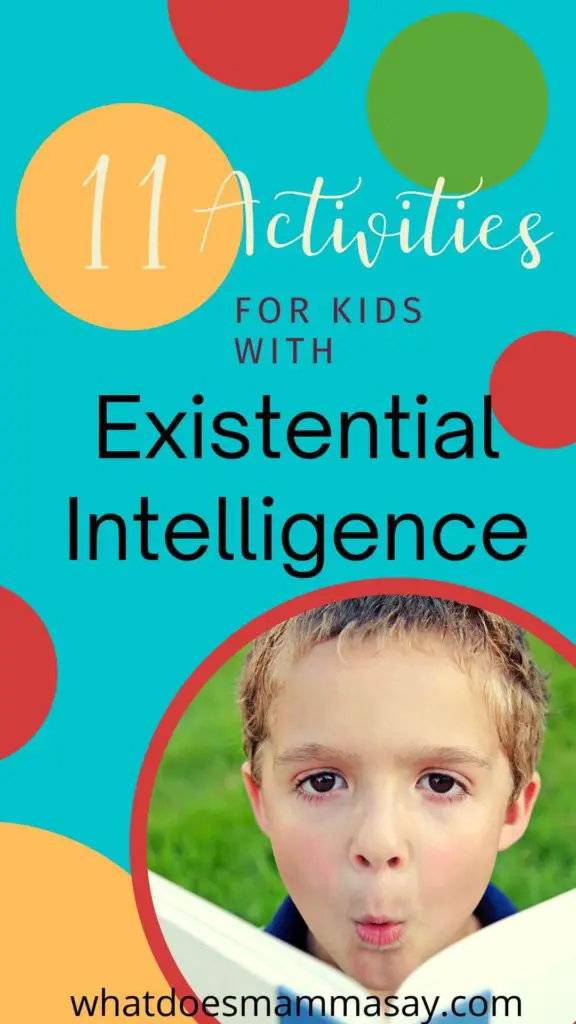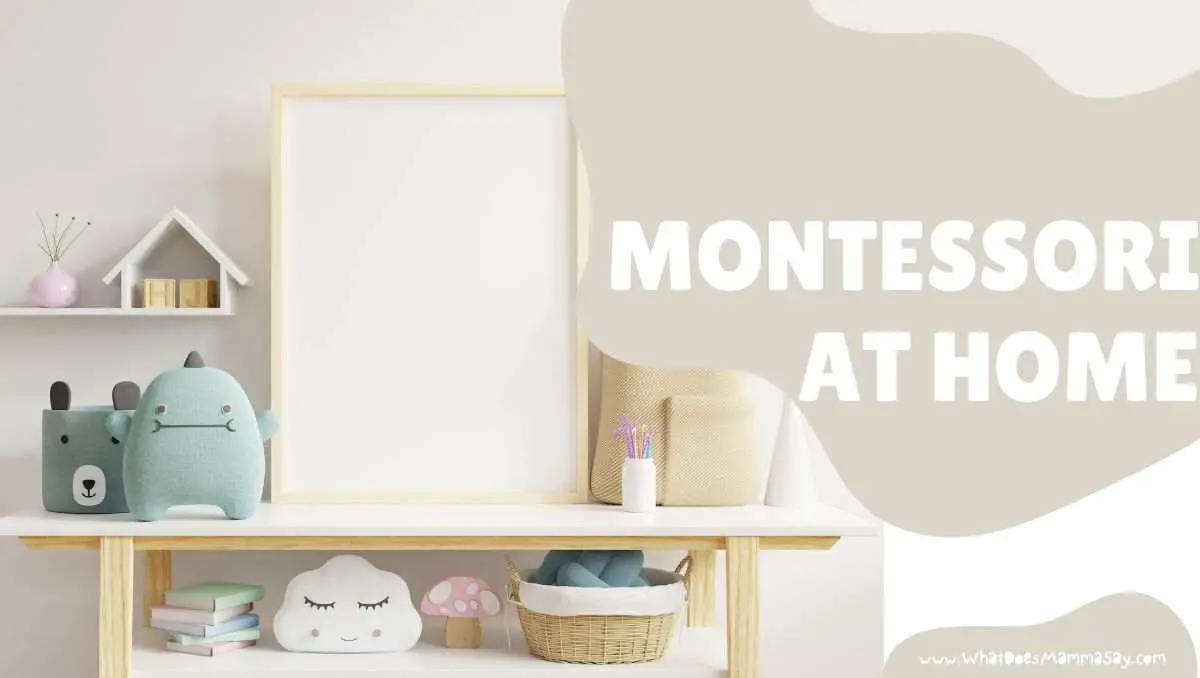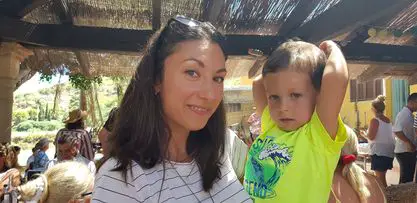In this post, you will learn what is existential intelligence, the characteristics that a learner with this type of intelligence has, 11 fantastic existential intelligence activities to refine or develop this ability and some tips on how to bring existentialism in the classroom or homeschooling setting.
Some time ago I have started a series of articles related to Multiple Intelligences activities that can be used both at home and in the classroom. You can check them out here.
As a teacher, I was fortunate enough to discover Howard Gardner’s revolutionary theory and work in a place that embraced it. Since then, I have created hundreds of lesson plans that incorporated the Multiple Intelligences Theory and came up with activities that would best suit my students’ skills, abilities and talents.
Through this series of articles, I wanted to bring visibility to Gardner’s theory that, at its core, encourages educators to regard children as individuals and promotes the idea that “one size fits all” is wrong when working with such a big diversity of skills and preferences.
Thus, I have shared with you activities for each of the eight intelligences that anyone can do either at home or in a classroom. And with this, in theory, the series of articles on the Multiple Intelligences activities should’ve been finished.
Except, there is another intelligence that is not on the official list: The Existential Intelligence.
12 years after introducing the Multiple Intelligences Theory in his book “Frames of Mind: The Theory of Multiple Intelligences” (1983), Gardner hypothesized that there might be a 9th intelligence, however, the existential intelligence hasn’t passed his test for various reasons. Even though the existential intelligence is not a “fully anointed” intelligence as far as Gardner is concerned, many have adopted it as “one of the gang”.
*Ah, not to mention that Howard Gardner has also contemplated a “pedagogical intelligence” but that is a story for another day, hehe*
Considering this and reading about Gardner’s reasons why this intelligence wasn’t included on the list, I have pondered whether I should write an article on existential intelligence activities or not. Gathering information on this ability I realised that this intelligence is as important as the rest, moreover, it is a vital skill to be taught and encouraged in children.
So, here we are. Another post from the multiple intelligences series, this time about activities for existential intelligence. But before we dive in, let’s clarify what existential intelligence is and what some of its characteristics may be.
This post may contain affiliate links and I may earn a small commission when you click on the links at no additional cost to you. As an Amazon Affiliate, I earn from qualifying purchases. You can read my full disclosure here.
What is Existential Intelligence?

According to Howard Gardner, existential intelligence is a person’s capacity to ponder and ask deep questions of philosophical nature such as “What is our purpose here? Where do our origins lie? Why do we die? What is consciousness? etc.
Even though philosophers, religious leaders, artworks and literature are more likely to ponder these big questions, each of us has at one point asked ourselves some of these questions. However, it’s not only adults that are concerned with “existential questions”. Almost all children will ask their caretakers some big questions. It is always fascinating to listen to young kids’ take on these questions.
Howard Gardner has made it clear that existential intelligence was not a religious, sacred or spiritual capacity. Although these existential questions can include religious and spiritual matters, they are not limited to these.
Besides the ability to ask deep questions, people with high existential intelligence can also see the big picture whether we are talking about a cosmic perspective (our place in the universe, our fragility but also our incredible potential) or someone who owns a company and needs to steer it in the right direction.
Characteristics of Existential Intelligence
Existential intelligence is perhaps not as common as logical-mathematical intelligence or visual-spatial one, especially in today’s society based on material things and consumerism. However, there are plenty of people who possess this skill. Here are a few existential intelligence characteristics:
– They tend to see the big picture
– They are highly intuitive
– They are often selfless and compassionate
– They are curious and ask lots of questions
– Their questions are philosophical in nature (life, death, the cosmos etc)
– They possess high moral values (charity, empathy, dependability, a love for peace, respect for life etc)
– They are good leaders
– They often have good critical thinking
– They take good care of themselves and the environment
– They have the ability to see different points of view
Read More:
Interpersonal Activities for Kids
Naturalistic Intelligence Activities for Kids
Activities for the Verbal Linguistic Learner
The Best Activities for Logical Mathematical Intelligence
Existential Intelligence Activities

Each of us is born with all the intelligences although in different “doses”. Thus, some people may have a more developed auditory intelligence while others may have a deeper connection to nature (naturalistic ability). However, having a predominant intelligence doesn’t mean that we can’t develop other abilities through specific activities.
Since existential intelligence is a good ability to refine, Here are a few fun existential intelligence activities for children.
1. Charity Work
Kids with an existential intelligence tend to be more empathetic and have a desire to help. So, doing some volunteer work would be a great way to hone those skills. Regardless of whether your child has an existential intelligence or not, doing charity work has incredible benefits not only for the cause they’re dedicating their time to but also for themselves (social benefits, teaches different life skills, gives a sense of purpose, promotes healthy habits and more).
Some causes that can be appropriate for children are feeding and playing with animals in an animals rescue centre, keeping seniors company in a retirement home or taking part in environmental cleaning projects where volunteers go to certain areas and clean them.
In addition to volunteer programs that kids can join, they can also donate some of their clothes and toys to those less fortunate or take them a homemade meal whenever possible.
2. Puzzle games
Doing puzzles have many benefits for the development of children. Besides developing fine motor skills, problem-solving skills, hand-eye coordination and visual perception, solving puzzles also encourages kids to keep in mind the big picture. Seeing the big picture is a prized skill, especially for leaders.
A fun game that I play with my son is Jigsaw Puzzle Treasure Hunt. It combines a classic jigsaw puzzle game with movement. It is easy. I choose a relatively small jigsaw puzzle (maximum of 10 pieces) and hide them around the room. I show my son an image of the constructed puzzle and he has to arrange the piece in the correct place as he finds them.


3. Questions and Answers Game
This is an activity that can be done anywhere as it doesn’t require any materials. Kids have extraordinary answers to some tricky questions so why not make a list and ask away. Just for fun, record or write down the answers.
A few questions that you can ask are:
– What is love?
– How did humans appear on Earth?
– How can we make Earth a better place?
– How do you think life will be in the future?
– How/Where are thoughts made?
– What are dreams?
– Why do people speak different languages?
– Do animals have feelings?
– Do you think that your dreams can influence reality?
4. Read about other cultures
The world is such a diverse place and nowadays, more than ever, we can learn about all those wonderful traditions around the globe. Exposing young children to other cultures will help them develop empathy, normalize the differences between people and enrich their vocabulary and knowledge.
A learner with existentialism intelligence will especially be interested in discovering details about how other people live and their habits. Reading books about other cultures is a wonderful way of learning about the wonderful diversity that makes each of us special. Make sure to discuss how things are similar or different from your culture.

5. Draw or paint a scene from a story
Not only are those with existential intelligence able to see the big picture but they are also able to break things into smaller bits. Ask them to draw or paint an image from a story that they’ve read and explain how their drawing fits into the story.
6. Write an opinion essay on a certain topic
This is an activity for slightly older kids who can write and are able to express their thoughts in a coherent way. Writing an opinion essay on a certain topic would be a good existential intelligence activity because it allows children to learn how to listen to other people’s views and agree or disagree in a respectful way. It will also encourage them to research and provide evidence in support of their arguments.
7. Guess what the book is about
Kids with existentialism intelligence are quite intuitive and can form an opinion with little information. A fun existential intelligence activity would be to show them the cover of a book and encourage them to try and guess what the book might be about. Ask for as many details as possible. Read the book and see if they were correct.
8. Imaginative play- The judge
Imaginative play is vital to the harmonious development of young children. The benefits are numerous and include the development of language, grasping and refining social skills, increasing creativity, developing problem-solving skills, learning how to navigate and solve conflicts, developing self-confidence and more.
An imaginative game that an existential intelligence child would enjoy is “The Judge”. It is a simple game that requires one child to listen carefully, regard the problem from different points of view and try to reach a fair solution.
One child will be the “Judge” while two others will be the plaintiff and the defendant. They will come in front of the judge with an issue and present their case with as many details as possible. The judge has to listen carefully, also ask questions if needed and in the end, come up with a solution.
9. Helping around the house
People with high existential intelligence like keeping their surroundings relatively clean and organised. So, it would be a good idea to encourage and involve little ones in house chores that are age appropriate. They can put their toys away, feed or groom the family pet, water the plants or help clean the house. To make things more attractive and fun, you can get them their own cleaning set like this one:

10. Explore nature with all senses
We are intrinsically connected to nature and a child with existential intelligence feels that connection as strong as a naturalistic intelligence person. Make sure that you allow children to explore nature with all their senses. Spending as much time in the middle of nature as possible has incredible benefits from mental and physical health to improving a child’s overall academic performance.
11. Help the animals and insects in your community
Make a bird feeder, a bee rejuvenation dish (a bit of sugary water) or set up a stray dog/cat feeding station where you put a bowl of food and one of water and you make sure to fill them up daily. This simple action will make kids feel like they are making a difference and teach them that all life is valuable and worth protecting.
Read More:
Musical Intelligence: Activities for Auditory Learners
Activities for Kids with Intrapersonal Intelligence
The Best Activities for Bodily Kinesthetic learners
Activities for the Visual Spatial Learner
Existentialism in the classroom
What is the purpose of education if not to inspire and motivate the future generation to take humanity to new heights? Even though an existential intelligence is trickier to identify in a student than the other intelligences, educators should incorporate practices that will make learners aware of their potential, develop their intuition, critical and creative thinking, help them see the big picture and ask important questions.
Howard Gardner stated (and parents will agree) that most children ask existential questions. However, it’s the children who listen to the answers and go on to explore their implications that signal a higher existential intelligence. One can pursue an answer in many ways, for example in imaginative play, thus the presence of existential intelligence might not always be evident to the adult observer.
Having said this, it may appear that teachers and homeschooling parents may have a tough time identifying students who possess this type of intelligence however, there are some activities that educators can do that will benefit both children with existential intelligence and those with less existential ability.
Teachers and homeschooling parents can bring existentialism to the classroom by
– Making connections between what they learn in the classroom to the outside world, whether it is something from your house, town, another culture or the universe.
– Organizing group discussions
– Switch to a discussion-style lesson instead of the more traditional, teacher-centred style (lecture style lesson)
– Constantly challenge students to see things from multiple perspectives
– Encourage students to summarize what they have learnt. Another way summarization can be used is for the teacher to present a summary of the lesson before teaching the full lesson.
– Challenge students to see the big picture by offering overviews
– Encourage students to ask as many questions as possible. For example, you could present them with the title of the lesson or a small part of the lesson and allow them 5 minutes to come up with a few questions. Also, always allow them to ask questions after the lesson.
– If possible, involve the kids in volunteering programmes that will make an impact in their community.

Final Thoughts
Even though existential intelligence is not officially part of the Multiple Intelligences List, (Howard Gardner states this clearly in a 2020 article ) I believe that it is an important ability to nurture both in kids and in adults.
After all, it is the people who ask questions and use their intuition, meta-cognition and logic to try to answer them, are the ones who drive humanity forward. Think Socrates, Budha, Albert Einstein or Elon Musk (love him or hate him he’s constantly pushing boundaries).
While this type of ability is not easy to identify, we can only benefit from a society that is preoccupied with developing existentialism intelligence in its young generation. This would mean a shift from the traditional teaching that prioritizes linguistic and mathematical intelligences to the detriment of others. Although it is a slow change, I feel that it is happening and more and more schools regard students as individuals with unique skills and preferences and adjust their lessons accordingly.
Hopefully, these existential intelligence activities will give you some inspiration for simple things to do with your kids to encourage them to explore this ability.
If you liked this article, please don’t forget to share it with your friends. Cheers! 🙂
Latest Posts
-
How To Teach Entrepreneurship to Children

Some of you may be wondering why even start the conversation about kid entrepreneurship with primary school-aged children. Doesn’t the common belief tell us that the focus of formative years … How To Teach Entrepreneurship to Children Read More »
-
Use Everyday Objects to Teach Kids Science

By embracing science as part of play-based learning, parents can create an environment where their child’s natural curiosity can flourish. Activities like exploring nature, conducting experiments with household items, or incorporating these elements into playtime can ignite a love for science, technology, engineering, and maths.
-
How to Teach Your Child Anger Management

“Kids who are oppositional or acting out in angry and aggressive ways often can’t explain how they’re feeling. They are overwhelmed, yet the only emotion they know how to communicate … How to Teach Your Child Anger Management Read More »
-
7 Free STEM Activities for Kids

In this article you will read about 7 free STEM activities that are easy to set up at home. You don’t need to be a scientist to teach your children … 7 Free STEM Activities for Kids Read More »
-
Growth mindset examples for students

Why Mindsets Matter As parents or educators, we are always on the lookout for the best parenting strategies or teaching methodologies that can help kids discover their full potential. For … Growth mindset examples for students Read More »
-
Montessori at Home- Independent and Reliable Kids

In this post, you can find out what exactly the Montessori approach is and how to start integrating Montessori at home to raise your children. Dr. Maria Montessori’s approach to … Montessori at Home- Independent and Reliable Kids Read More »
-
Learn and play – what the experts say

Psychology has had a major influence on how play is perceived today, most notably in educational settings. The field of psychology influenced the field of child development by offering facts … Learn and play – what the experts say Read More »

Mom of two wonderful children, dedicated teacher and book lover.



